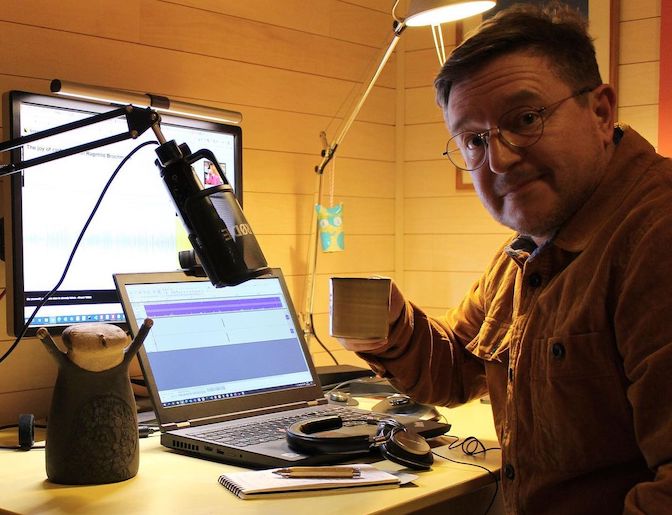Fashion + Design > Fashion
December 22, 2021
Great listening – Nick Johannessen’s Podcast Garmology
Susanne Barta
Auf den Podcast „Garmology“ hat mich Roland Novak, der Botschafter des guten Stils, hingewiesen. Und ich habe auch gleich hineingehört. Gefällt mir sehr, vor allem die Gespräche über nachhaltige Modethemen. Ich empfehle euch da zum Beispiel das Gespräch mit Melissa Watts oder mit Ragnhild Brochmann. Dass den Podcast ein in Sachen Bekleidung sehr versierter Mann macht, gefällt mir auch, das bringt andere Perspektiven ins Blickfeld. Und dieser Mann ist Nick Johannessen, er lebt in Norwegen und bloggt seit 2013 als „Well Dressed Dad“ über „slower menswear“ und „ethical, sustainable and fun fashion“ – hier sein Instagram-Account. Tweed, Workwear, Denim und Vintage gehören Nicks besondere Aufmerksamkeit, seine verschiedenen Plattformen bespielt er auf Englisch.
Nick, how come you are so intensely involved with fashion?
I’m not sure I’d say I am! I have very little interest in the actual world of what I see as fashion, as in the continuously changing and disposable styles that we tend to think of as fashion. I’m more into the anti-fashion, or really the actual clothes, the cloths and the stories behind it. This is where my idea for Garmology came into being. My work is very far from the world of fashion, which hopefully gives me an outsider’s perspective, but also means that the efforts I put into the blog and podcast are entirely due to my keen interest in the matter. How would you describe your clothing style?
How would you describe your clothing style?
It’s very much a mix of influences. There’s some British country style with the tweeds, some vintage workwear, denim style, army influences, a bit of US ivy and preppy. Basically, it’s a mix of things I feel work together, but not with a conscious or planned end result, so I’m not locked in to being specially a country gentleman, or a 1920′s worker, but freely mix to achieve a pleasurable end result. The common thread, so to speak, is that it’s all quality and lasting garments, clothes I have collected because I like them, clothes that can be resold or given to others if I grow out of them or tired of them and that can be repaired if they are damaged. And most importantly, they bring me joy, both when I wear them and when I look at them. Yes, I am both a wearer and collector.
Who is your podcast “Garmology” addressed to and what do you want to create with it?
The podcast is an evolving project where I talk with people, I find interesting within the world of the garments we wear. The selection of guests ranges from designers to weavers, from wearers to sellers, from academics to influencers, basically hearing experiences and points of views from people we might never have heard from. It’s as much about the joy of clothes as the problems of it, as I hope to find a way to reduce our consumption through buying only what we need and love. The question of how we can create clothes wearers will cherish has been an ongoing question. So far, with over 70 episodes, the feedback has been excellent. In one of your podcast episodes, you talked about how you don’t like to use the term “sustainable fashion”. Is sustainable fashion mainly an empty buzzword today?
In one of your podcast episodes, you talked about how you don’t like to use the term “sustainable fashion”. Is sustainable fashion mainly an empty buzzword today?
The problem in using the word fashion is that it is precisely the aspect of fashion we need to move away from. This idea of buying and discarding our clothes are increasingly short intervals, replacing our wardrobe with items that are designed to have a limited life span, is such a huge part of the problem of overproduction and overconsumption. So, bringing in slow fashion or sustainable fashion appears to signal that fashion is not the problem, it’s only the speed of the cycles that is bad. What we really need to focus on is garments that are outside fashion, will last a long time, and that we will actually use until they are used up. The real challenge as I see it isn’t making good garments, that is easy to solve, but to create garments that we will enjoy and use because they feel and look great, not because they are this week’s trending item. There is also a problem of garments being marketed as “sustainable fashion” being merely more fashion with a new buzzword. If we stop to think for a moment, is making more clothes really the sustainable option? I despair when I see people asking “What can I buy to become more sustainable?”.
I recently spoke with a renowned climate scientist. He said that we need to stop consuming as soon as possible. In other words, we should only work with what we already have. How do you see this?
It is an inarguable fact that we already have mountains of clothing lying unused, either by way of secondhand, army surplus, vintage and what is awaiting recycling or just landfill. Around 80-90% of clothes donated to charity in Norway are just sent directly to Eastern Europe, where they will be picked for resale, sent for recycling into products like sound insulation for cars, or repackaged and exported to Africa and other interested buyers. This is wrong on so many levels, as low-cost mixed fiber garments are almost impossible to recycle, clothes made from polyester can really only be incinerated to reclaim the fossil energy and sending waste clothes to Africa is both killing their home clothes industry and building up massive landfills of unwanted and unusable Western clothes. The best way to deal with unwanted clothes is to give or sell them to someone who will use them and do so until they reach the end of their life. Sadly, this doesn’t apply to polyester and plastics-based garments as they will increasingly release microplastics as they get older. This means that buying that “vintage” 90′s polyester training jacket and thinking you are sustainable is totally wrong. How optimistic are you that the fashion industry is changing?
How optimistic are you that the fashion industry is changing?
I’m not really all that optimistic. While the large companies have to give profits to their shareholders, they have very little incentive to change their ways. It may be possible with sufficient laws to regulate how they operate, but even then, they will place business before change. We see this very clearly now, with the rampant greenwashing taking place, where they wildly and willfully misrepresent their products, manipulate their customers into buying more (customer clubs, in store recycling bins, special deals etc.). It’s all about keeping and increasing sales, not actually selling more sustainable garments, which would mean less sales.
I see a lot of potential in small brands selling direct to consumers, offering a more tailored and personal service. An example would be a shirt that fits you, in a fabulous fabric, at a price that means the maker has an acceptable profit, and by cutting out the overhead to the big company and retailers, a lower price to the customers. In a way it’s moving back to having production in every village, instead of the global production we have now. What else?
What else?
Maybe more information will help people make informed choices? There is a lot of “recycled polyester” being sold now, with makers claiming this is much better than “virgin polyester” made from fossil oil. Realizing that “recycled polyester” releases as much microplastics as the usual polyester hints that it might only be marginally “better”, rather than being anywhere close to actually sustainable. Given that most of this polyester is made from downcycled plastic bottles make the picture even worse. Why downcycled? Because plastic bottles can be recycled many times, but once made into polyester they have reached the end of their potential. The worst case I heard of was a maker buying new bottles to recycle, as they couldn’t find used ones of sufficient quantity and quality.
This newspeak and vague way of describing sustainability is a huge problem though, as in companies will very carefully word their marketing and communications to consumers to imply more than they are actually committing to. Unless consumers are very well informed, it is easy to fall for this trickery. Sehr interessant und vor allem wichtig, was Nick zu sagen hat. Also nichts wie hineinhören in den Podcast! Hier geht’s zu Garmology, hier geht’s zu Nicks Blog und hier zu seinem Instagram … Die Weihnachtszeit eignet sich ja bestens mit etwas mehr Ruhe spannende Sachen zu hören. Weitere Hör- und vor allem Lese-Tipps gibt’s nächste Woche. Merry Christmas!
Sehr interessant und vor allem wichtig, was Nick zu sagen hat. Also nichts wie hineinhören in den Podcast! Hier geht’s zu Garmology, hier geht’s zu Nicks Blog und hier zu seinem Instagram … Die Weihnachtszeit eignet sich ja bestens mit etwas mehr Ruhe spannende Sachen zu hören. Weitere Hör- und vor allem Lese-Tipps gibt’s nächste Woche. Merry Christmas!
Fotos © Nick Johannessen


















Comments